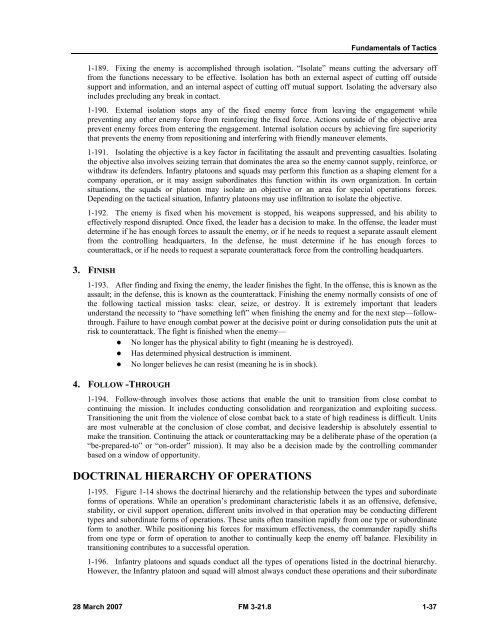Infantry Rifle Platoon and Squad - Sakai
Infantry Rifle Platoon and Squad - Sakai
Infantry Rifle Platoon and Squad - Sakai
Create successful ePaper yourself
Turn your PDF publications into a flip-book with our unique Google optimized e-Paper software.
Fundamentals of Tactics<br />
1-189. Fixing the enemy is accomplished through isolation. “Isolate” means cutting the adversary off<br />
from the functions necessary to be effective. Isolation has both an external aspect of cutting off outside<br />
support <strong>and</strong> information, <strong>and</strong> an internal aspect of cutting off mutual support. Isolating the adversary also<br />
includes precluding any break in contact.<br />
1-190. External isolation stops any of the fixed enemy force from leaving the engagement while<br />
preventing any other enemy force from reinforcing the fixed force. Actions outside of the objective area<br />
prevent enemy forces from entering the engagement. Internal isolation occurs by achieving fire superiority<br />
that prevents the enemy from repositioning <strong>and</strong> interfering with friendly maneuver elements.<br />
1-191. Isolating the objective is a key factor in facilitating the assault <strong>and</strong> preventing casualties. Isolating<br />
the objective also involves seizing terrain that dominates the area so the enemy cannot supply, reinforce, or<br />
withdraw its defenders. <strong>Infantry</strong> platoons <strong>and</strong> squads may perform this function as a shaping element for a<br />
company operation, or it may assign subordinates this function within its own organization. In certain<br />
situations, the squads or platoon may isolate an objective or an area for special operations forces.<br />
Depending on the tactical situation, <strong>Infantry</strong> platoons may use infiltration to isolate the objective.<br />
1-192. The enemy is fixed when his movement is stopped, his weapons suppressed, <strong>and</strong> his ability to<br />
effectively respond disrupted. Once fixed, the leader has a decision to make. In the offense, the leader must<br />
determine if he has enough forces to assault the enemy, or if he needs to request a separate assault element<br />
from the controlling headquarters. In the defense, he must determine if he has enough forces to<br />
counterattack, or if he needs to request a separate counterattack force from the controlling headquarters.<br />
3. FINISH<br />
1-193. After finding <strong>and</strong> fixing the enemy, the leader finishes the fight. In the offense, this is known as the<br />
assault; in the defense, this is known as the counterattack. Finishing the enemy normally consists of one of<br />
the following tactical mission tasks: clear, seize, or destroy. It is extremely important that leaders<br />
underst<strong>and</strong> the necessity to “have something left” when finishing the enemy <strong>and</strong> for the next step—followthrough.<br />
Failure to have enough combat power at the decisive point or during consolidation puts the unit at<br />
risk to counterattack. The fight is finished when the enemy—<br />
• No longer has the physical ability to fight (meaning he is destroyed).<br />
• Has determined physical destruction is imminent.<br />
• No longer believes he can resist (meaning he is in shock).<br />
4. FOLLOW -THROUGH<br />
1-194. Follow-through involves those actions that enable the unit to transition from close combat to<br />
continuing the mission. It includes conducting consolidation <strong>and</strong> reorganization <strong>and</strong> exploiting success.<br />
Transitioning the unit from the violence of close combat back to a state of high readiness is difficult. Units<br />
are most vulnerable at the conclusion of close combat, <strong>and</strong> decisive leadership is absolutely essential to<br />
make the transition. Continuing the attack or counterattacking may be a deliberate phase of the operation (a<br />
“be-prepared-to” or “on-order” mission). It may also be a decision made by the controlling comm<strong>and</strong>er<br />
based on a window of opportunity.<br />
DOCTRINAL HIERARCHY OF OPERATIONS<br />
1-195. Figure 1-14 shows the doctrinal hierarchy <strong>and</strong> the relationship between the types <strong>and</strong> subordinate<br />
forms of operations. While an operation’s predominant characteristic labels it as an offensive, defensive,<br />
stability, or civil support operation, different units involved in that operation may be conducting different<br />
types <strong>and</strong> subordinate forms of operations. These units often transition rapidly from one type or subordinate<br />
form to another. While positioning his forces for maximum effectiveness, the comm<strong>and</strong>er rapidly shifts<br />
from one type or form of operation to another to continually keep the enemy off balance. Flexibility in<br />
transitioning contributes to a successful operation.<br />
1-196. <strong>Infantry</strong> platoons <strong>and</strong> squads conduct all the types of operations listed in the doctrinal hierarchy.<br />
However, the <strong>Infantry</strong> platoon <strong>and</strong> squad will almost always conduct these operations <strong>and</strong> their subordinate<br />
28 March 2007 FM 3-21.8 1-37

















